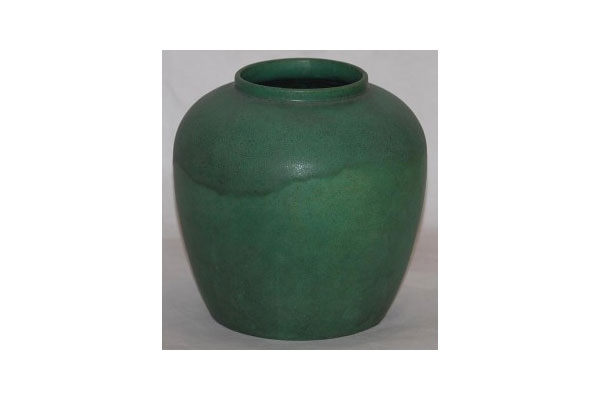In what began as a brick and tile company, the Terra Cotta Tile Works Company was founded in 1881. William Gates didn’t introduce the pottery line until two decades later in 1902. Within a decade of introducing the pottery line, there were more than 500 designs. Most are familiar with the simple, though lovely, matte green glaze, which encompasses nearly the entire collection. While that certainly lends to its unique presentation, there’s no denying the the forms and the role they play in Teco’s popularity.
Advertisements
 One ad, dated 1908 reads “Teco Pottery is extensively in demand for prizes and presents”. The black and white advertisement features one of Teco’s vases with side “pockets” that add a bit of dimension to the look, along with a narrow neck that flares up and out at the vase opening. It then goes on to say the pottery is “especially suitable for Christmas Presents, also Bridge Whist prizes”. It’s an interesting combination in terms of what the ad suggests.
One ad, dated 1908 reads “Teco Pottery is extensively in demand for prizes and presents”. The black and white advertisement features one of Teco’s vases with side “pockets” that add a bit of dimension to the look, along with a narrow neck that flares up and out at the vase opening. It then goes on to say the pottery is “especially suitable for Christmas Presents, also Bridge Whist prizes”. It’s an interesting combination in terms of what the ad suggests.
One thing’s for sure, though, claims in this particular ad that Teco Pottery is “the pottery of restful, peaceful green and is remarkable for its purity of line and newness of design” are right on target. This truly is a collector’s dream. It’s popular, it can still be located and purchased without blowing your budget and it’s timeless. It’s as lovely and appropriate on a coffee table or shelf today as it was then.
Prairie School Influences
As mentioned, the decorative pottery line was introduced in 1902 and the timing couldn’t have been better as it is the epitome of the “prairie school” arts and crafts movement, courtesy of Frank Lloyd Wright, that was the “must have” in that time period. The traditional Teco pottery forms are best defined as either geometric (“architectural” is used often) or organic. While the most used color glaze was the matte green, collectors can locate pieces that incorporate reds and browns, too.
It’s not known the exact date Teco Pottery ceased its American art pottery lines, it’s believed it went until at least the mid 1920s.


